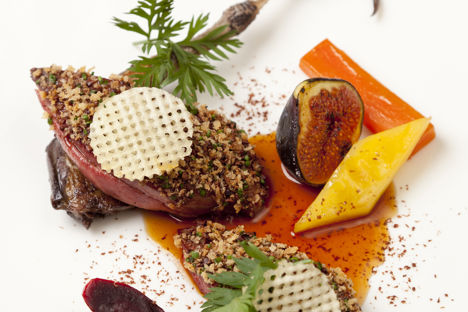
Ingredient focus: grouse
Grouse will not be found in the supermarkets so pop along to your local butcher to request this special treat that is now in season. A tasty, unusual and wild alternative to roast chicken not to be missed in the coming months.
Ingredient focus: grouse
Grouse will not be found in the supermarkets so pop along to your local butcher to request this special treat that is now in season. A tasty, unusual and wild alternative to roast chicken not to be missed in the coming months.
The ‘Glorious 12th’ of August is the official start of game season in the UK, beginning with a very British species of bird, the grouse. Heather is 90 percent of the grouse’s diet and therefore they are found on the 1,250 heather moors of Britain, usually in Scotland and Yorkshire but also in Northumberland. Grouse have been hunted in the UK for over 200 years, originally by royalty and aristocracy. In recent years, the sport has become popular with chefs wanting to get in touch with the source of their food. The majority of the grouse shot are red grouse; other species include black grouse and ptarmigan however these birds are verging on endangered and should not be shot.
Flavour profile
Grouse is probably the strongest tasting of the game birds and its unique flavour gets stronger throughout the season. Its dark meat starts off with the most delicate notes of game and heather and soon progresses deeper to a flavour with hints of leather and a slight bitterness which isn’t unpleasant. Some prefer to hang grouse for a number of days but the flavour can become overpowering and offensive if hung for too long.
The heart and liver of the grouse can also be eaten and are considered somewhat of a delicacy; cook them quickly for the best results and expect a strong, rich, iron flavour.
Food matches
Traditionally served with a very simple bread sauce and game chips, the flavour of grouse actually goes well with so many more interesting and exciting ingredients; these vary throughout the season as the flavour of the bird gets deeper and more gamey. Grouse is often cooked wrapped in rashers of smoky bacon, but this practice was traditionally used to mask the flavour of old birds and the bacon suppresses the real flavour of the meat.
Young grouse pairs beautifully with sweet berries and red fruits; begin the season with cherries and move on to blackcurrants and blackberries, figs and plums in the autumn and finish in the winter with rich, dense prunes or slow-cooked quinces. Use strong, bitter leaves such as chicory and watercress to offset the sweetness of the fruit and to balance the plate. Foie gras is also a welcome addition to grouse, if a somewhat luxurious treat.
Grouse works well with other strong and smoky flavours such as whisky (Famous Grouse, of course), smoked tea such as Lapsang Souchong and chocolate but be sure to use these in small amounts as too much will overpower the flavour of the meat rather than complement it.
The richness of walnuts and chestnuts happily complement grouse and the two seasons coincide perfectly in the autumn and winter respectively.
Did you know?
The glorious 12th August is specified as the eggs of the grouse hatch in May and by August the chicks are no longer reliant on their parents. This law was passed in 1773 however it was commonly disregarded at that time and was reinforced in the Game Act of 1831.
The age of a grouse can be identified by the third feather of its wing: a short feather indicates a young bird whilst a long feather means the bird is older, from the previous season.
Up to 250,000 grouse are shot between the start of the season on 12th of August and the close on the 10th of December.

